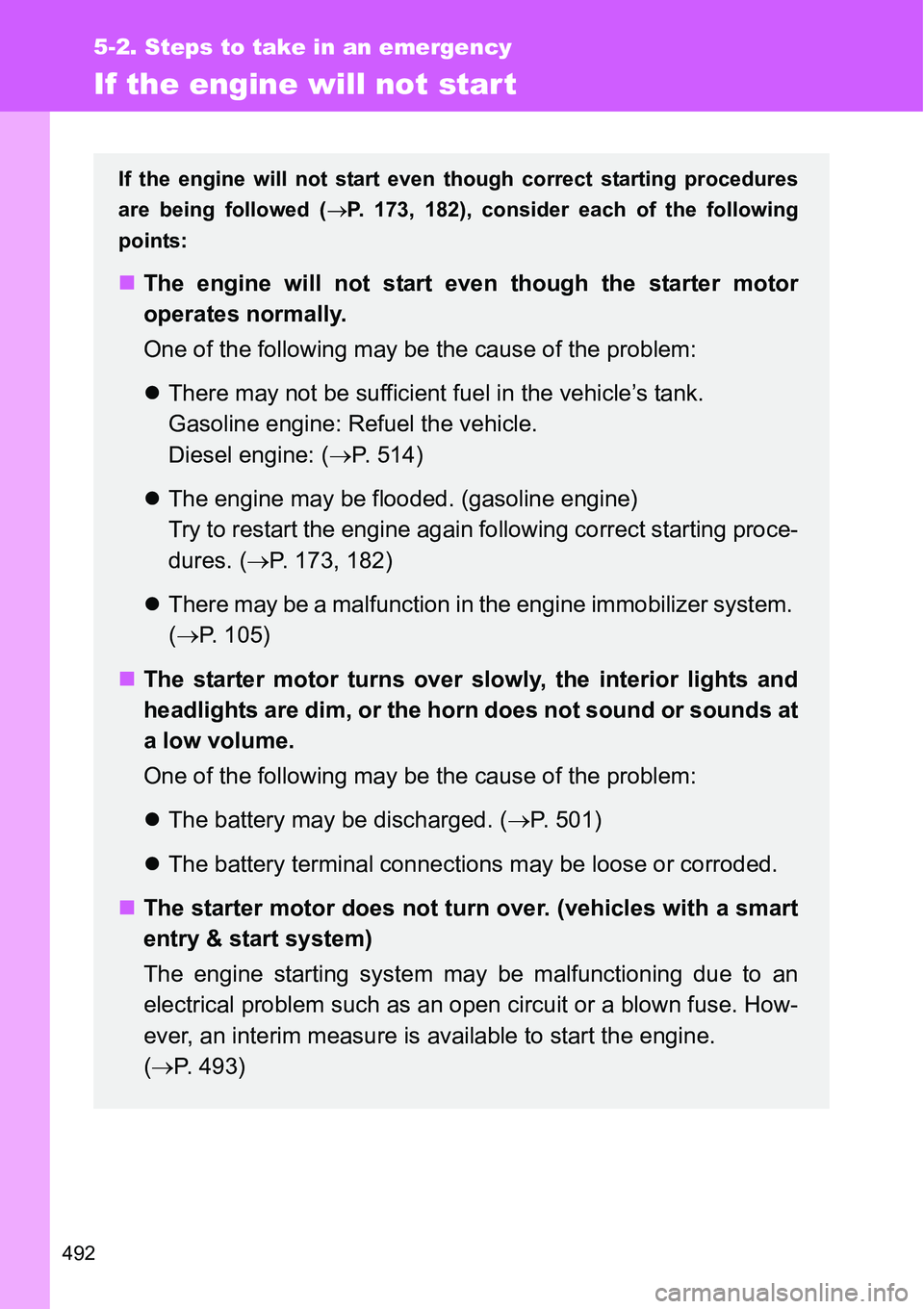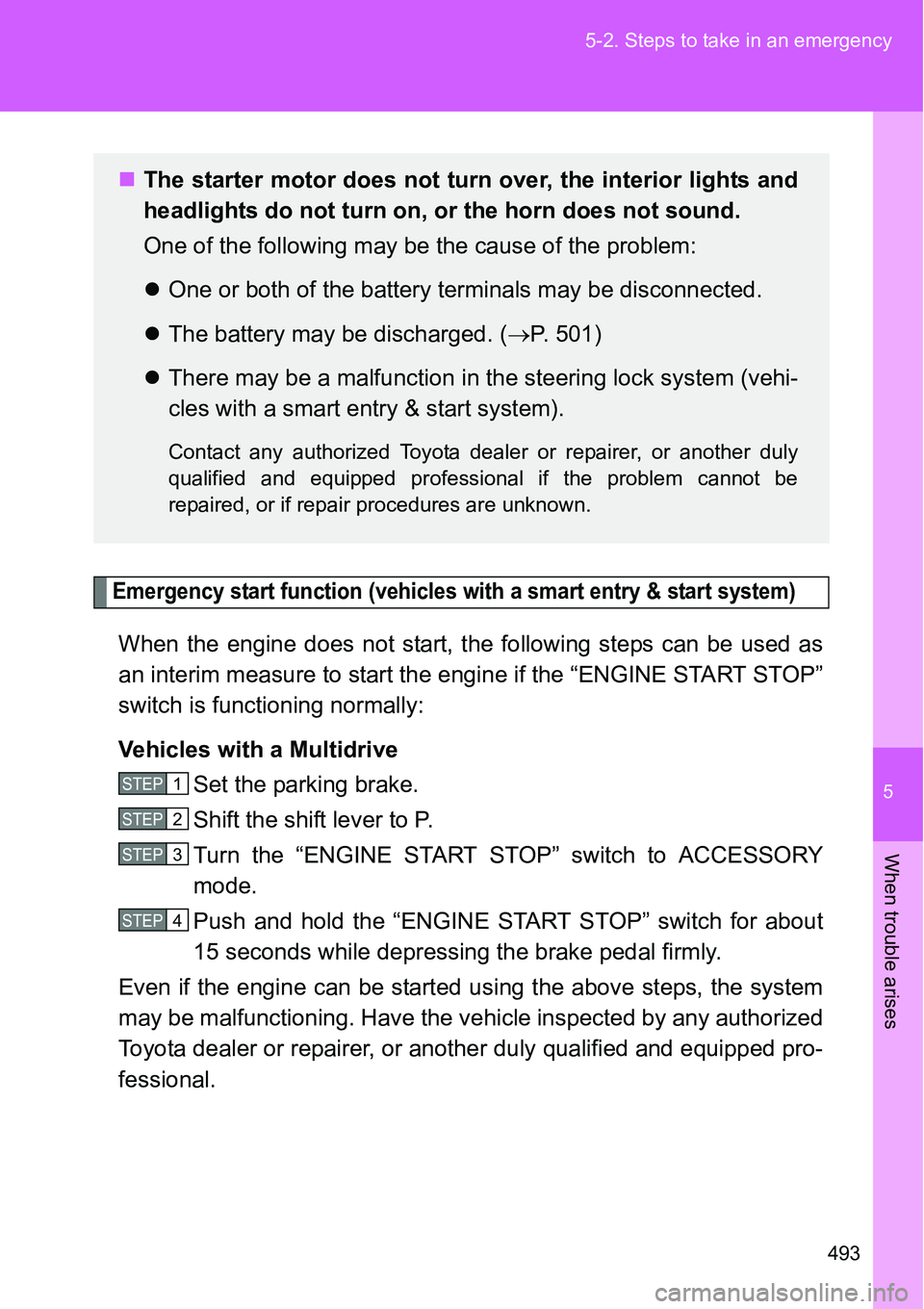Page 417 of 564
417 4-3. Do-it-yourself maintenance
4
Maintenance and care
Ty p e B
FuseAmpereCircuit
1EU-DRL 7.5 A
2S-HORN 10 AMultiport fuel injection system/
sequential multiport fuel injection
system
3 H-LP MAIN 7.5 A Headlights
4 H-LP RH HI 10 A Right-hand headlight (high beam)
5H-LP LH HI 10 ALeft-hand headlight (high beam),
gauge and meters
6 H-LP RH LO 10 A Right-hand headlight (low beam)
7 H-LP LH LO 10 ALeft-hand headlight (low beam),
manual headlight leveling dial
Page 423 of 564
423
4-3. Do-it-yourself maintenance
4
Maintenance and care
Light bulbs
You may replace the following bulbs by yourself. The difficulty level
of replacement varies depending on the bulb. If necessary bulb
replacement seems difficult to perform, contact any authorized
Toyota dealer or repairer, or another duly qualified and equipped
professional.
For more information about replacing other light bulbs, contact any
authorized Toyota dealer or repairer, or another duly qualified and
equipped professional.
Preparing for light bulb replacement
Check the wattage of the light bulb to be replaced. (P. 536)
Front bulb locations
Front fog lights
(if equipped)
Headlights
Front turn
signal lights
Page 424 of 564
424 4-3. Do-it-yourself maintenance
Replacing light bulbs
Headlights
Remove the cover.
Turn the bulb base counterclock-
wise remove it.
Rear bulb locations
Rear fog light (for
left-hand traffic)/
Back-up light (for
right-hand traffic)
Rear fog light (for
right-hand traffic)/
Back-up light (for
left-hand traffic)
License plate
lights
Rear turn signal lights
STEP1
STEP2
Page 425 of 564
425 4-3. Do-it-yourself maintenance
4
Maintenance and care
Unplug the connector while
pressing the lock release.
Replace the light bulb, and install
the bulb base.
Align the 3 tabs on the light bulb
with the mounting and insert.
Turn and secure the bulb base.
Shake the bulb base gently to
check that it is not loose, turn the
headlights on once and visually
confirm that no light is leaking
through the mounting.
Install the cover.
STEP3
STEP4
STEP5
STEP1STEP6
Page 433 of 564
433 4-3. Do-it-yourself maintenance
4
Maintenance and care
CAUTION
Replacing light bulbs
Turn off the lights. Do not attempt to replace the bulb immediately after
turning off the lights.
The bulbs become very hot and may cause burns.
Do not touch the glass portion of the light bulb with bare hands. When it is
unavoidable to hold the glass portion, use and hold with a clean dry cloth
to avoid getting moisture and oils on the bulb.
Also, if the bulb is scratched or dropped, it may blow out or crack.
Fully install light bulbs and any parts used to secure them. Failure to do so
may result in heat damage, fire, or water entering the headlight unit. This
may damage the headlights or cause condensation to build up on the lens.
To prevent damage or fire
Make sure bulbs are fully seated and locked.
Page 492 of 564

492
5-2. Steps to take in an emergency
If the engine will not start
If the engine will not start even though correct starting procedures
are being followed (P. 173, 182), consider each of the following
points:
The engine will not start even though the starter motor
operates normally.
One of the following may be the cause of the problem:
There may not be sufficient fuel in the vehicle’s tank.
Gasoline engine: Refuel the vehicle.
Diesel engine: (P. 514)
The engine may be flooded. (gasoline engine)
Try to restart the engine again following correct starting proce-
dures. (P. 173, 182)
There may be a malfunction in the engine immobilizer system.
(P. 105)
The starter motor turns over slowly, the interior lights and
headlights are dim, or the horn does not sound or sounds at
a low volume.
One of the following may be the cause of the problem:
The battery may be discharged. (P. 501)
The battery terminal connections may be loose or corroded.
The starter motor does not turn over. (vehicles with a smart
entry & start system)
The engine starting system may be malfunctioning due to an
electrical problem such as an open circuit or a blown fuse. How-
ever, an interim measure is available to start the engine.
(P. 493)
Page 493 of 564

5
493 5-2. Steps to take in an emergency
When trouble arises
Emergency start function (vehicles with a smart entry & start system)
When the engine does not start, the following steps can be used as
an interim measure to start the engine if the “ENGINE START STOP”
switch is functioning normally:
Vehicles with a Multidrive
Set the parking brake.
Shift the shift lever to P.
Turn the “ENGINE START STOP” switch to ACCESSORY
mode.
Push and hold the “ENGINE START STOP” switch for about
15 seconds while depressing the brake pedal firmly.
Even if the engine can be started using the above steps, the system
may be malfunctioning. Have the vehicle inspected by any authorized
Toyota dealer or repairer, or another duly qualified and equipped pro-
fessional.
The starter motor does not turn over, the interior lights and
headlights do not turn on, or the horn does not sound.
One of the following may be the cause of the problem:
One or both of the battery terminals may be disconnected.
The battery may be discharged. (P. 501)
There may be a malfunction in the steering lock system (vehi-
cles with a smart entry & start system).
Contact any authorized Toyota dealer or repairer, or another duly
qualified and equipped professional if the problem cannot be
repaired, or if repair procedures are unknown.
STEP1
STEP2
STEP3
STEP4
Page 505 of 564
5
505 5-2. Steps to take in an emergency
When trouble arises
Starting the engine when the battery is discharged (vehicles with a
Multidrive)
The engine cannot be started by push-starting.
To prevent battery discharge
Turn off the headlights and the audio system while the engine is off.
Turn off any unnecessary electrical components when the vehicle is run-
ning at a low speed for an extended period, such as in heavy traffic.
Charging the battery
The electricity stored in the battery will discharge gradually even when the
vehicle is not in use, due to natural discharge and the draining effects of cer-
tain electrical appliances. If the vehicle is left for a long time, the battery may
discharge, and the engine may be unable to start. (The battery recharges
automatically during driving.)
Once the engine starts, have the vehicle checked at any autho-
rized Toyota dealer or repairer, or another duly qualified and
equipped professional, as soon as possible.